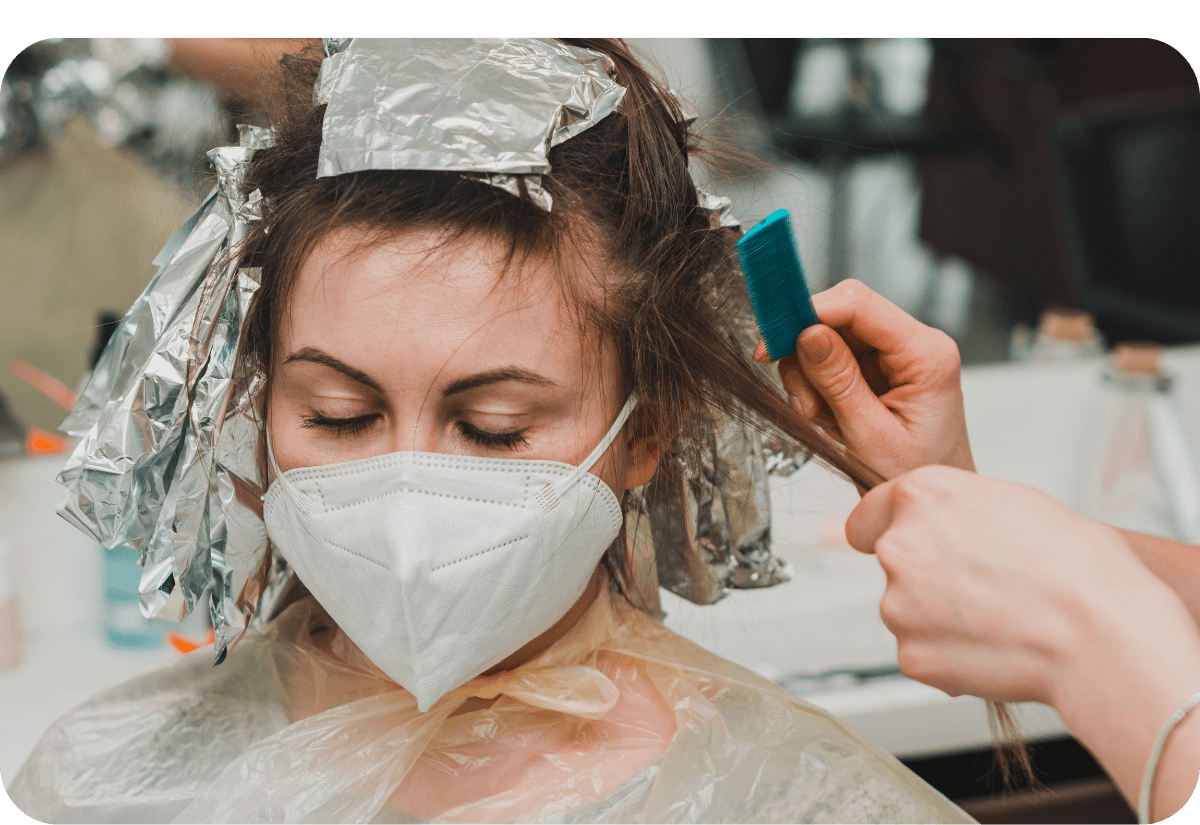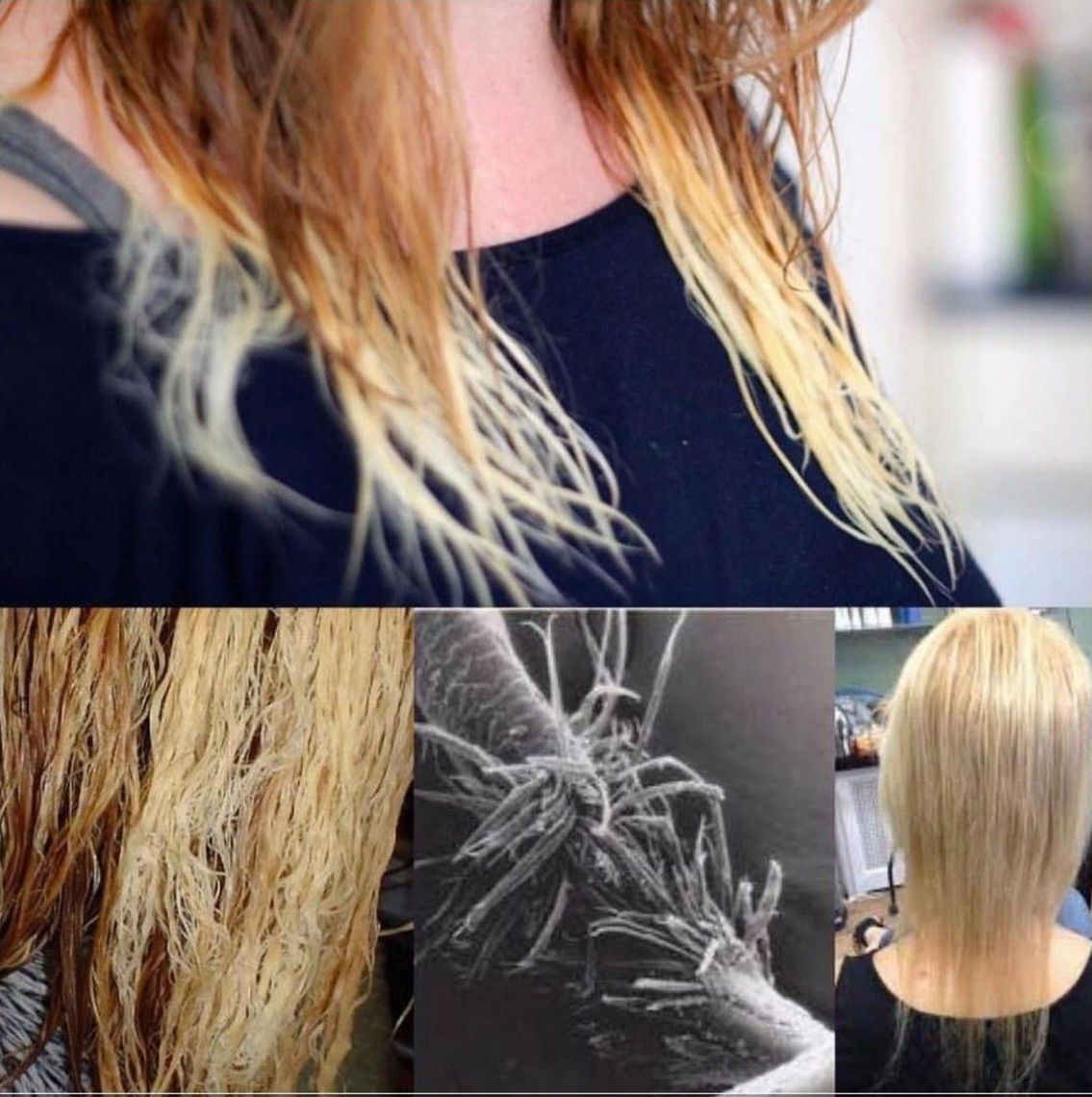Over Processed Bleached Hair - Your Guide To Healthy Locks
Transforming your hair color, especially going for a lighter shade or a bright blonde, feels pretty exciting, doesn't it? That fresh, light look can feel like a whole new you. But sometimes, in the pursuit of that ideal sunny glow, our hair might just get a little too much of a good thing, leading to some unexpected challenges. You see, the journey to lighter strands can be a delicate one, and it's easy for things to go a bit awry if we're not careful.
When hair has had more than its fair share of strong treatments, like those used for making it lighter, it can start to show signs of strain. This condition, often called "over processed bleached hair," means the hair's natural strength and bounce have taken a hit. It might not feel or look the way you want it to, and styling can become a real headache, too it's almost a daily struggle.
The good news, though, is that recognizing these signs early and knowing what to do can make a big difference. There are ways to bring your hair back to a happier, healthier state, and even better, steps you can take to keep it from getting to that point in the first place. This guide is here to walk you through what happens, how to spot it, and what you can do to help your hair feel good again, you know, really good.
- Chen Senior
- Where Do All The Celebrities Live In Los Angeles
- Balenciaga Hair Clips
- Cyber Monday Sale Air Purifier
- Benaffleck Nude
Table of Contents
- What Happens to Over Processed Bleached Hair?
- How Can You Tell if Your Hair is Over Processed Bleached Hair?
- What Causes Over Processed Bleached Hair?
- Can Over Processed Bleached Hair Be Fixed?
- How to Prevent Over Processed Bleached Hair in the Future?
What Happens to Over Processed Bleached Hair?
When hair goes through a lot of chemical changes, especially with strong lighteners, its inner makeup changes quite a bit. Think of your hair strands like tiny, strong ropes, made up of many smaller fibers held together. Bleaching works by getting right inside these ropes, changing the natural color. But if this process goes on for too long, or if it's done too often, those strong ropes start to fray. Basically, the hair gets hurt by the chemicals, and it loses its natural strength. It's almost like stretching a rubber band until it gets thin and breaks, you know? That's what happens to over processed bleached hair.
The Inner Workings of Over Processed Bleached Hair
At its core, hair that has been lightened too much becomes quite open and full of tiny holes. Normally, your hair has a protective outer layer, a bit like scales on a fish, that keeps moisture in and keeps the strand smooth. When hair gets over processed bleached hair, this outer layer can lift up or even break away in places. This leaves the inside of the hair exposed and vulnerable. As a result, the hair can't hold onto water like it should, which is pretty important for keeping it soft and bendy. It also makes the hair feel rougher to the touch, and it might not have that healthy, reflective shine it once did, so it's a bit of a problem.
How Can You Tell if Your Hair is Over Processed Bleached Hair?
Spotting hair that's had too much chemical attention is usually quite clear once you know what to look for. It's not just about how it looks, but also how it feels in your hands. You might notice changes pretty quickly after a lightening session, or they could show up over time if you're regularly coloring your hair. It's really about paying attention to the signals your hair is sending you, and that can be a little tricky at first.
Feeling Your Over Processed Bleached Hair
One of the most common signs of over processed bleached hair is how it feels when you touch it. If your hair feels like dry straw, or like a piece of cotton that's been pulled apart, then that's a big hint. It might feel rough and coarse, rather than smooth and soft. When it's wet, it could feel strangely stretchy, almost gummy, and might even break off very easily when you gently pull on it. This is because the internal structure has been weakened, and it can't hold itself together like it should. You might also find it hard to comb through, as it tangles up quite a bit, making daily styling a real chore.
Seeing Your Over Processed Bleached Hair
Beyond the feel, there are also visual clues that point to over processed bleached hair. You might see a lot more split ends than usual, or even bits of hair breaking off at different lengths, creating a frizzy, uneven look. The hair might appear dull and lifeless, lacking any natural luster or bounce. Sometimes, the color itself can look a bit off, perhaps brassy or too light in certain spots, almost translucent. It just doesn't seem to hold its shape well, and trying to style it can feel like trying to arrange a bunch of loose threads, which is pretty frustrating, honestly.
What Causes Over Processed Bleached Hair?
Hair doesn't just become over processed bleached hair on its own; it's usually the result of certain actions or a build-up of various treatments. Understanding what leads to this condition is a big step in preventing it or helping your hair recover. It's often a combination of factors, rather than just one single thing, that pushes hair past its breaking point. So, it's worth considering all the possibilities.
Common Culprits Behind Over Processed Bleached Hair
The main reason hair gets over processed bleached hair is simply too much exposure to strong chemical treatments. This includes repeatedly lightening the hair, especially if it's done too frequently without enough time for the hair to rest and recover. Chemical straightening treatments, which also alter the hair's structure, can contribute to the damage. Even using a lot of heat styling tools, like flat irons and curling wands, without proper heat protection can make things worse. Basically, anything that puts a lot of stress on the hair's natural makeup can lead to it becoming weak and damaged, you know, really damaged.
Can Over Processed Bleached Hair Be Fixed?
When your hair feels like it's seen better days because of too much lightening, it's easy to feel a bit hopeless. But the good news is that hair can often be helped, and sometimes even brought back to a much healthier state. It takes some patience and the right kind of care, but it's definitely possible to see improvement. It's not an instant fix, of course, but a steady effort can make a real difference for your over processed bleached hair.
Steps to Help Your Over Processed Bleached Hair
One of the most immediate and helpful things you can do for over processed bleached hair is to get a haircut. Getting rid of those frayed, split ends makes a huge difference, as those damaged parts can't really be repaired and will only continue to split further up the hair strand. Beyond that, focusing on gentle care is key. Use very mild shampoos and conditioners, and try to wash your hair less often. Deep conditioning treatments, which are like a big drink of water for your hair, can help bring back some softness and flexibility. Using a wide-tooth comb on wet hair, and being very gentle, can also prevent further breakage. You really want to treat your hair like it's made of delicate silk, you know, just very, very carefully.
When it comes to treatments, there are many products out there designed to help repair hair that's been through a lot. These often contain ingredients that aim to strengthen the hair from the inside out. However, when it comes to protein treatments, which can be very strong, it's often best to leave those to someone who really knows what they're doing. Trying to do complex protein treatments at home without proper guidance can sometimes make the problem worse, if you're not careful. It's a bit like trying to fix a complicated engine without knowing how all the parts work together, so, you could cause more harm than good.
Professional Help for Over Processed Bleached Hair
Sometimes, the damage to over processed bleached hair is quite extensive, and at-home remedies might not be enough. This is when seeing a hair professional, like a stylist who specializes in hair health, can be incredibly helpful. They can assess the true condition of your hair and suggest in-salon treatments that are much more concentrated and effective than what you can buy off the shelf. They might use specialized bonding treatments that work to rebuild the hair's internal structure. A professional can also give you a tailored plan for at-home care and advise you on when it's safe to consider any further chemical services. Basically, they've got the tools and the know-how to really give your hair a fighting chance, as a matter of fact.
How to Prevent Over Processed Bleached Hair in the Future?
The best way to deal with over processed bleached hair is, of course, to keep it from happening in the first place. Prevention is always better than trying to fix something once it's already broken. By making some thoughtful choices and being mindful of your hair's limits, you can enjoy lighter shades without sacrificing its health. It's about finding that sweet spot where beauty and well-being meet, honestly.
Smart Choices for Your Hair to Avoid Over Processed Bleached Hair
If you love having lighter hair, it's really important to give it breaks between chemical services. Don't rush into another bleaching session if your hair is already feeling fragile. Listen to your hair; if it feels like straw or is breaking, that's a clear sign to hold off. Always go to a skilled and trusted stylist who understands the science of hair lightening and can assess your hair's condition before applying chemicals. They can tell you if your hair is ready for another round or if it needs more time to recover. Also, make sure to use good quality products at home that are designed for chemically treated hair, and always, always use a heat protectant spray if you're using hot tools. It's like putting on sunscreen for your hair, you know, just really important.
Consider asking your stylist about bond-building treatments that can be added directly into the bleach mixture. These products are pretty amazing because they help protect the hair's internal bonds during the lightening process, which can greatly reduce the risk of over processed bleached hair. They act as a sort of shield, allowing you to achieve your desired lightness with less damage. And remember, a healthy diet and plenty of water also play a part in overall hair health, so that's something to think about, too. Taking care of your body helps your hair, basically.
This guide has walked through what happens when hair gets too much bleaching, how you can spot the signs of over processed bleached hair, what causes it, and practical steps you can take to help it recover. We've looked at why hair becomes porous and fragile, the tell-tale signs like a straw-like feel or excessive breakage, and the role of frequent chemical or heat treatments. We also covered the importance of haircuts, gentle care, specific treatments, and seeking professional advice for severe damage. Finally, we explored preventative measures, such as spacing out chemical services, using protective products, and choosing a knowledgeable stylist to avoid future issues with over processed bleached hair.

Guide to Managing Bleached Hair With the Right Products

Over processed Hair | April 2021 | Gustav Fouche

Eye-Catching Styles for Bleached Hair | LoveHairStyles.com